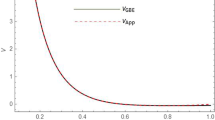Abstract
A relativistic model of independent quarks based on Dirac equation with an equally mixed scalar-vector square root confining potential is used to compute the quark core contributions to study the static properties like magnetic moments of the decuplet \(\Delta \) baryons. The results obtained with inclusion of appropriate centre-of-mass motion corrections agree well with experimental values. The overall predictions so obtained compare well with other model predictions. The outcomes from this study is expected to inspire for progresses and further unravelling other light baryons additionally to experimental facilities PANDA-GSI.
Similar content being viewed by others
References
H.J. Lee, Discussion on scalar meson \(a_0\)(980) as a Tetraquark State with the QCD sum rules including the contribution from instanton. New Phys. Sae Mulli 72(12), 887–892 (2022)
M. Karliner, J.L. Rosner, Configuration mixing in strange tetraquarks Zcs. Phys. Rev. D 104(3), 034033 (2021)
M. Bagchi, M. Dey, S. Daw, J. Dey, A Model finding a new Richardson potential with different scales for confinement and asymptotic freedom, by fitting the properties of Delta++ and Omega-. Nucl. Phys. A 740, 109–118 (2004)
F.X. Lee, Determination of decuplet baryon magnetic moments from QCD sum rules. Phys. Rev. D 57, 1801–1821 (1998)
T.M. Aliev, A. Ozpineci, Magnetic moments of decuplet baryons in light cone QCD. Phys. Rev. D 62, 053012 (2000)
R. Roncaglia, D.B. Lichtenberg, E. Predazzi, Predicting the masses of baryons containing one or two heavy quarks. Phys. Rev. D 52, 1722–1725 (1995)
D. Ebert, R.N. Faustov, V.O. Galkin, Masses of heavy baryons in the relativistic quark model. Phys. Rev. D 72, 034026 (2005)
C. Menapara, Z. Shah, A. Kumar Rai, Spectroscopic properties of \(\Delta \) baryons. Chin. Phys. C 45(2), 023102 (2021)
S. Capstick, N. Isgur, Baryons in a relativized quark model with chromodynamics. Phys. Rev. D 34(9), 2809–2835 (1986)
N. Mathur, R. Lewis, R.M. Woloshyn, Charmed and bottom baryons from lattice NRQCD. Phys. Rev. D 66, 014502 (2002)
M. Shah, B. Patel, P.C. Vinodkumar, Spectroscopy and flavor changing decays of B, B\(_s\) mesons in a Dirac formalism. Phys. Rev. D 93(9), 094028 (2016)
M. Shah, B. Patel, P.C. Vinodkumar, Mass spectra and decay properties of \(D_s\) Meson in a relativistic Dirac formalism. Phys. Rev. D 90(1), 014009 (2014)
M. Shah, B. Patel, P.C. Vinodkumar, Mass Spectra of \(B\), \(B_s\) Mesons using Dirac formalism with martin-like confinement potential. DAE Symp. Nucl. Phys. 59, 650–651 (2014)
P.C. Vinodkumar, M. Shah, B. Patel, Pseudoscalar decay constant of \(B\) and \(B_s\) mesons using Dirac formalism. DAE Symp. Nucl. Phys. 60, 676–677 (2015)
P.C. Vinodkumar, M. Shah, B. Patel, Hadronic and Leptonic decay widths of \(D\) and \(D_s\) Mesons using Dirac formalism. DAE Symp. Nucl. Phys. 59, 638–639 (2014)
M. Shah, B. Patel, P.C. Vinodkumar, Mass spectra and decay properties of \(D\) Meson in a relativistic Dirac formalism. Eur. Phys. J. C 76(1), 36 (2016)
N. Amiri, M. Ghapanvari, M.A. Jafarizadeh, Transitional description of mass spectra for baryons in the U(7) model. Eur. Phys. J. Plus 136(2), 141 (2021)
E. Santopinto, J. Ferretti, Strange and nonstrange baryon spectra in the relativistic interacting quark-diquark model with a Gürsey and Radicati-inspired exchange interaction. Phys. Rev. C 92(2), 025202 (2015)
M. Aslanzadeh, A.A. Rajabi, Spectroscopy of light baryons in a semi-relativistic constituent three-quark model. Int. J. Mod. Phys. E 26(07), 1750042 (2017)
M.M. Giannini, E. Santopinto, A. Vassallo, Hypercentral constituent quark model and isospin dependence. Eur. Phys. J. A 12, 447–452 (2001)
G. Eichmann, Theory introduction to baryon spectroscopy. Few Body Syst. 63(3), 57 (2022). https://doi.org/10.1007/s00601-022-01756-y
N. Barik, S.N. Jena, Phys. Rev. D. 26, 2420 (1982)
W. Lucha, F. Schoberl, Int. J. Mod. Phys. C 10, 607 (1998)
R.L. Workman et al. [Particle Data Group], Rev. Part. Phys. PTEP 2022, 083C01 (2022)
D. Ebert et al., Spectroscopy and Regge trajectories of heavy baryons in the relativistic quark-diquark picture. Phys. Rev. D 84, 014025 (2011)
M. Kotulla, J. Ahrens, J.R.M. Annand, R. Beck, G. Caselotti, L.S. Fog, D. Hornidge, S. Janssen, B. Krusche, J.C. McGeorge et al., The Reaction gamma p–\(>\) pi zero gamma-prime p and the magnetic dipole moment of the delta+(1232) resonance. Phys. Rev. Lett. 89, 272001 (2002)
A. Bosshard, C. Amsler, M. Doebeli, M. Doser, M. Schaad, J. Riedlberger, P. Truoel, J.A. Bistirlich, K.M. Crowe, S. Ljungfelt et al., Analyzing power in pion proton bremsstrahlung, and the Delta++ (1232) magnetic moment. Phys. Rev. D 44, 1962–1974 (1991)
D.B. Leinweber, T. Draper, R.M. Woloshyn, Decuplet baryon structure from lattice QCD. Phys. Rev. D 46, 3067–3085 (1992)
K. Thakkar, B. Patel, A. Majethiya, P.C. Vinodkumar, Properties of light flavour baryons in hypercentral quark model. Pramana 77, 1053–1067 (2011)
F. Schlumpf, Magnetic moments of the baryon decuplet in a relativistic quark model. Phys. Rev. D 48, 4478–4480 (1993)
P. Ha, L. Durand, Baryon magnetic moments in a QCD based quark model with loop corrections. Phys. Rev. D 58, 093008 (1998)
Author information
Authors and Affiliations
Corresponding author
Additional information
Publisher's Note
Springer Nature remains neutral with regard to jurisdictional claims in published maps and institutional affiliations.
Rights and permissions
Springer Nature or its licensor (e.g. a society or other partner) holds exclusive rights to this article under a publishing agreement with the author(s) or other rightsholder(s); author self-archiving of the accepted manuscript version of this article is solely governed by the terms of such publishing agreement and applicable law.
About this article
Cite this article
Patel, S., Shah, M. Study of Static Properties of \(\Delta \) Baryon Resonances in the Relativistic Potential Model Formalism. Few-Body Syst 64, 37 (2023). https://doi.org/10.1007/s00601-023-01820-1
Received:
Accepted:
Published:
DOI: https://doi.org/10.1007/s00601-023-01820-1



